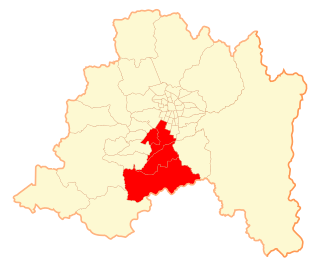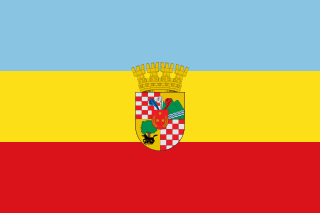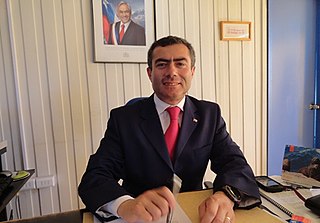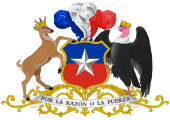
Chile is divided into 16 regions, which are the country's first-level administrative division. Each region is headed by an intendant (intendente), appointed by the President of Chile, and a directly elected regional board.
An intendant was and sometimes still is a usually public official, especially in France, Spain, Portugal, and Latin America. The intendancy system was a centralizing administrative system developed in France. In the War of the Spanish Succession of 1701 to 1714 the French royal House of Bourbon secured its hold on the throne of Spain; it extended a French-style intendancy system to Spain and Portugal - and subsequently worldwide through the Spanish Empire and Portuguese Empire. Regions were divided into districts, each administered by an intendant. The title continues in use in Spain and in parts of Spanish America for particular government officials.

The Dominican Republic is divided into thirty–one provincias, while the national capital, Santo Domingo, is contained within its own Distrito Nacional.

Arica Province is one of two provinces of Chile's northernmost region, Arica y Parinacota. The province is bordered on the north by the Tacna Province of Peru, on the south by the Tamarugal Province in the Tarapacá Region, on the east the Parinacota Province and on the west by the Pacific Ocean. Its capital is the port city of Arica.

Iquique Province is one of two provinces in the northern Chilean region of Tarapacá. Its capital is the port city of Iquique.

Antártica Chilena Province is the southernmost and one of four provinces in Chile's southernmost region, Magallanes and Antártica Chilena Region (XII). The capital is Puerto Williams. The province comprises the extreme southern part of Isla Grande de Tierra del Fuego, the islands south and west of Isla Grande, and Chile's claims in Antarctica. The province is administratively divided into two communes (comunas): Cabo de Hornos, located at the southern tip of South America, and Antártica, a wedge-shaped claim of Antarctica, which is not internationally recognized. Its total area of 1,265,853.7 km2 (488,749 sq mi) makes it almost twice as large as all other provinces of Chile combined.

A province is the second largest administrative division in Chile with 56 in total. The largest administrative division in Chile is that of a region with 16 in total.

Chacabuco Province is one of six provinces of the Santiago Metropolitan Region in central Chile. It is located north of the Province of Santiago, which is entirely urbanized and part of the Santiago conurbation. The provincial capital, Colina, lies approximately 27 km (17 mi) north of Santiago.

Maipo Province is one of six provinces in the Santiago Metropolitan Region of central Chile. Its capital is San Bernardo.

A commune is the smallest administrative subdivision in Chile. It may contain cities, towns, villages, hamlets as well as rural areas. In highly populated areas, such as Santiago, Valparaíso and Concepción, a conurbation may be broken into several communes. In sparsely populated areas, conversely, a commune may cover a substantial rural area together with several settled areas which could range from hamlets to towns or cities.

Talagante Province is one of six provinces of the Santiago Metropolitan Region in central Chile. The capital is the city of Talagante, located approximately 35 km (22 mi) southwest of the national capital of Santiago. The most northeastern part of the province is included in the Santiago conurbation.

San Bernardo is a city of Chile, part of the Greater Santiago conurbation. Administratively, it is a commune and the capital of the Maipo Province in the Santiago Metropolitan Region. It is the seat of the Roman Catholic Diocese of San Bernardo.
Valparaíso Province is one of eight provinces of the central Chilean region of Valparaíso (V). Its capital is the coastal city of Valparaíso.

Quillota Province is one of eight provinces of the central Chilean region of Valparaíso (V). Its capital is the city of Quillota.
Melipilla Province is one of six provinces in the Santiago Metropolitan Region of central Chile. The provincial capital is the city of Melipilla.
A province is almost always an administrative division within a country or state. The term derives from the ancient Roman provincia, which was the major territorial and administrative unit of the Roman Empire's territorial possessions outside Italy. The term province has since been adopted by many countries. In some countries with no actual provinces, "the provinces" is a metaphorical term meaning "outside the capital city".

Marga Marga Province is one of the eight provinces in the central Chilean region of Valparaíso (V). Its capital is the city of Quilpué.
Llay-Llay is a town and commune in the San Felipe de Aconcagua Province of central Chile's Valparaíso Region.

Julio Diego Ibarra Maldonado is a Chilean politician. Ibarra was the Governor of Cardenal Caro Province since he was appointed by President of Chile Sebastián Piñera on March 16, 2010. He left office on March 12, 2014.

Luis Guastavino Córdova was a Chilean teacher and politician who was Intendant of the Valparaíso Region. He also served as deputy between 1965 and 1973, including Salvador Allende's Marxist government (1970−1973).















